50 Famous Firearms You've Got to Own: Rick Hacker's Bucket List of Guns (2015)
REMINGTON 870
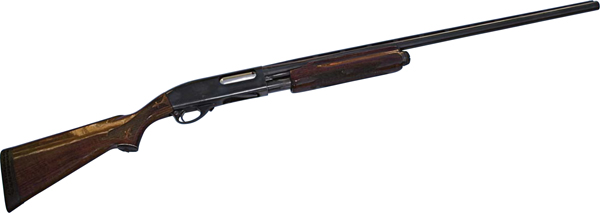
One of my hunting buddies has amassed a rather impressive collection of shotguns. Securely stored in his safe are some of the finest Parkers, Brownings, and Winchesters ever seen outside a museum. He shoots them all, yet when we go upland hunting or gear up for waterfowl, there is only one of his many scatterguns he invariably selects—an old, beat-up, synthetically stocked 12-gauge Remington 870 Wingmaster. His reason? “It always works,” he says.
Quoting from one of Remington’s fairly recent catalogs:
The original design of the Model 870 Wingmaster is so smooth and so reliable that today—more than five decades after its introduction—it’s still the standard by which all other pump-action shotguns are judged. … Its classic balance and natural pointing qualities provide the handling speed for the most evasive and challenging birds … . And because they practically never wear out, there are more Model 870s in use today than any other shotgun.
That would be well over nine million Model 870s to date, making this the most prolific and popular pump-action shotgun ever produced. But before the emergence of the Model 870, Remington had already been enjoying a fair amount of success with its five-shot Model 31, a 12-gauge pump that had been introduced in August 1931, hence the name. It had been the company’s first side-ejecting repeating shotgun, but it got off to a slow start in those early years of the Great Depression. Nonetheless, 16- and 20-gauge versions were brought out in 1933. Even during a lull in production caused by World War II, a number of Model 31s were conscripted into the service to help train aerial gunners. But by 1947, with peacetime prosperity on the horizon and being left behind by Winchester’s popular Model 12, Remington—the country’s oldest arms maker—decided it was time to update its Model 31.
In January 1950, after three years of planning, the Model 870 Wingmaster made its appearance with sleek new styling, a greatly improved and strengthened action, and priced at $69.95 for the AP Standard Grade. This launched the Model 870 with a definite competitive advantage over the field grade Winchester Model 12, which was selling for $98.15 at the time. But in spite of its dramatically lower price, the Wingmaster would still end up being one of the most reliable and versatile smoothbores ever built. Its unique “twin action bars”—thin steel rails that extended into the receiver from both sides of the sliding forearm—gave the pump-action a ball bearing smoothness that resulted in quick follow-up shots on fast-moving targets. In addition, the bolt locked into a barrel extension, making for a rock-solid action.
The streamlined Model 870 featured a walnut pistol grip stock and fore-end and a swept-back trigger guard with cross-bolt safety. The smooth receiver, machined from a solid block of steel, was matted to reduce top glare. Initially chambered for 23⁄4-inch shells, the Wingmaster loaded from the bottom and boasted a takedown action, easily interchangeable barrels for switching to different lengths and chokes, and a tubular magazine that held five rounds; a three-shot wooden plug was standard, and 12-gauge guns came with an alternate steel “Vari-Weight” steel plug. The Deluxe versions offered a checkered pistol grip, checkered and grooved fore-end, a fully matted barrel ridge, and decorative grip cap. Internally, both guns were the same.
Remington’s faith in its newest scattergun was evident by the introduction of no less than 15 different versions of the Model 870—in 12-, 20-, and 16-gauge—that very first year. Models included Special, Deluxe, and Deluxe Special Grades, in addition to a variety of trap and skeet guns, plus a 20-inch barreled riot gun. Indeed, when it came to the Model 870, there was something for everyone and it was an immediate success with hunters, competitive shooters, and law enforcement agencies, as well as the military.
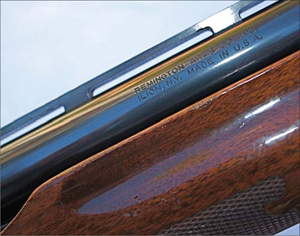
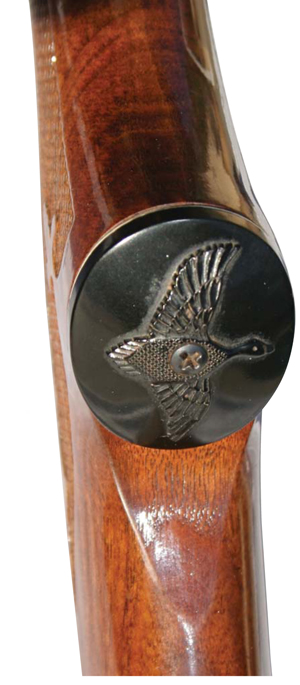
The butt cap of this Wingmaster leaves no doubt as to the shotgun’s intended purpose.
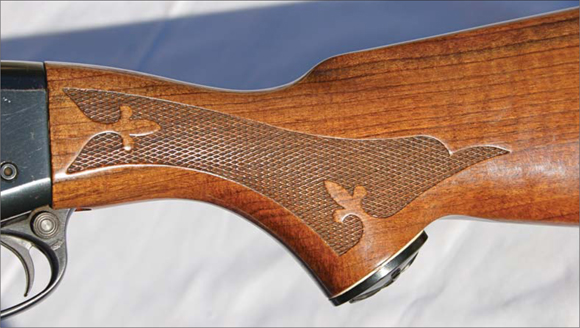
The fleur de lis checkered pattern adds a touch of elegance to the Model 870’s glossy walnut stock.
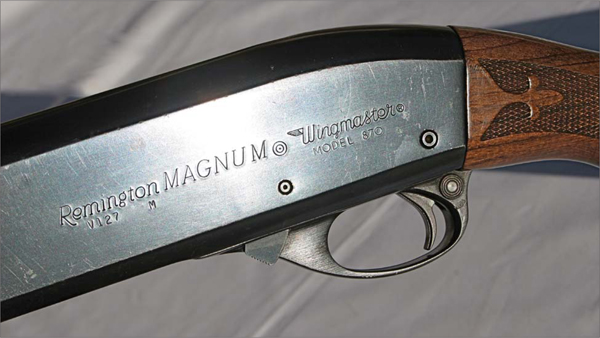
This particular gun was made in 1978 and is chambered for 12-gauge 3-inch Magnums.
In 1955, a magnum 12-gauge chambering for 3-inch shells was added. The versatility of the Model 870 was extended further in 1959, when the open-sighted RSS Rifled Slug Special was introduced; of course, slug barrels could also be purchased separately by those who already owned the basic 870 shotgun. A 20-gauge magnum came out in 1960, and three years later even the lowest-priced field grades were upgraded with checkering, providing ever greater value. Small wonder that by 1966, just 16 years after its introduction, more than a million Model 870s had been sold. As this also marked the one hundred-fiftieth anniversary of the Remington Arms Company, which had been started by Eliphalet Remington in 1816, that year saw the shotgun’s first commemorative, the Model 870 150th Anniversary Edition, of which 2,534 were made. Three years later, 28-gauge and .410-bore versions were brought out, featuring appropriately scaled-down receivers with lighter-weight mahogany stocks.
Over the course of its still-active lifetime, the Model 870 has existed in a mind-boggling array of variations, including the Mk-1 military model with extended seven-shot magazine, left-handed versions (which first came out in 1971), the Lightweight Deer Gun, Lightweight 20-Gauge Youth Gun, commemoratives such as the 12-gauge “100th Anniversary of Pump-Action Shotguns,” and the economical 870 Express. From synthetically stocked marine models to camouflaged turkey guns to magnum duck guns to tactical models, the Remington 870 remains one of the most versatile and affordable pump-actions in the world.